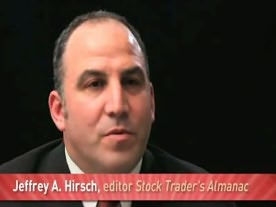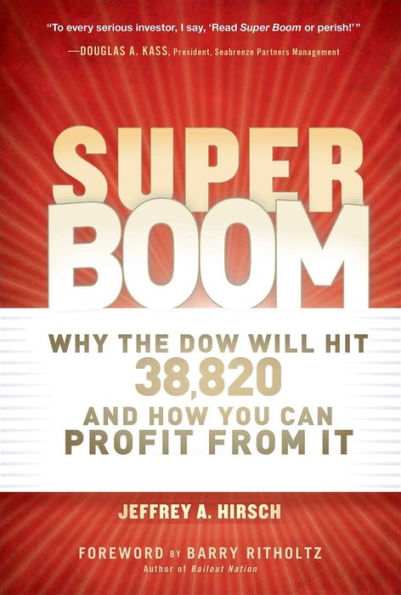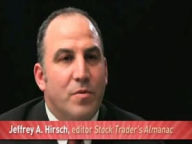
Super Boom: Why the Dow Jones Will Hit 38,820 and How You Can Profit From It
208
Super Boom: Why the Dow Jones Will Hit 38,820 and How You Can Profit From It
208Hardcover(Reprint)
-
PICK UP IN STORECheck Availability at Nearby Stores
Available within 2 business hours
Related collections and offers
Overview
In 1976, Yale Hirsch predicted a fifteen-year super boom—a move in the stock market of 500% or more. His forecast proved accurate as the market rose and continued upward, eventually posting growth over 1,000% just before the tech crash in 2000. In Super Boom, Jeffrey Hirsch, President of the Hirsch Organization and Editor in Chief of the Stock Trader's Almanac, unveils the next market expansion. Building on his father's research from 1976, Hirsch has discovered that meteoric rises in stock indices are due to specific catalysts predominantly outside of the financial markets.
History has a way of repeating itself, especially in the financial markets. The American economy, and subsequently the world economy, has always existed in a cycle of boom and bust: gold, grain, oil, technology, and most recently, real estate, have all bubbled and popped. The key to investing profitably is spotting macroeconomic historical trends and positioning to reap the benefits. Step-by-step, Hirsch puts together the pieces of this puzzle by revealing the central drivers of a super boom.
- Examines how new cultural paradigm-shifting technologies, as well as peace between major wars, could fuel a super boom
- Discusses how the massive injection of money by the government, in response to the global financial crisis and the Great Recession, as well as wartime spending, will eventually create an inflationary environment
- The data and research found here is based on historical information and the boom-and-bust cycle of the past century
As markets and economies struggle over the next several years, remember to keep your eye on the future and get ready for the coming super boom and the next 500% move in the market. With this book as your guide, you'll benefit from the insights that only Jeffrey Hirsch can provide.

Product Details
| ISBN-13: | 9781118024706 |
|---|---|
| Publisher: | Wiley |
| Publication date: | 04/05/2011 |
| Edition description: | Reprint |
| Pages: | 208 |
| Sales rank: | 719,264 |
| Product dimensions: | 6.10(w) x 9.10(h) x 0.90(d) |
About the Author
Visit www.stocktradersalmanac.com for Jeff’s blog, information about market cycles, tools, research, and more.
Read an Excerpt
Table of Contents
Foreword ixAcknowledgments xiii
PART I Anatomy of a Super Boom
Chapter 1 The Boom Equation 3The math behind the move
Chapter 2 A Strangled Economy 15From slump to powerhouse
PART II The Fortune Tellers
Chapter 3 The History of Ignorance and the Ignorance of History 37Dow 36,000 and the dangers of erroneous assumptions
Chapter 4 An Argument against Financial Calamity 49The best case for and against all hell breaking loose
Chapter 5 Yale Hirsch and the 500 Percent Move 57Discovering the boom pattern
PART III Booms and Busts of the Twentieth Century
Chapter 6 Panics, World War I, and the Roaring Twenties 81From the Rich Man's Panic to the first recorded super boom
Chapter 7 Depression, World War II, and the Baby Boom 87The greatest generation births a boom
Chapter 8 Vietnam, Stagflation, and the Information Revolution 95The greatest boom ever: bigger, faster, longer, higher
PART IV The Prodigal Pattern Returns
Chapter 9 Inflation 111The history and impact of the Consumer Price Index
Chapter 10 Investment Ideas and Strategies 129How to profit now and during a super boom
Appendix A Yale Hirsch's 1977 Stock Picks 149
Appendix B 1977 Smart Money Newsletter Reprinted 161
Key Terms 171
About the Author 175
Index 177
Reading Group Guide
10 Ways You Can Invest Now to Profit from the Coming Super Boom
By Jeffrey Hirsch,
Stock Traders Almanac Editor-In Chief
and author of
Super Boom: Why the Dow Jones Will Hit
38,820 and How You Can Profit From It
My long term forecast for the stock market is for a 500% move from the March 2009 low to Dow 38,820 by the year 2025. A time of relative global peace with a reduced U.S. combat military presence overseas, accompanied by increased inflation and new paradigm-shifting technological breakthroughs will conspire to drive stock market to new heights 10, 15, 20 years down the road. However, the bulk of this historic leap in stock prices is not projected to commence for another 6 or 7 years when the next secular bull market gets underway.
The key to profiting from this massive bull market rally is preparing yourself now and over the next several years while the market continues to move sideways, so that you're not chasing the rally, but rather in perfect position to ride the wave of growth and gains all the way to the top. Being right about this future move will be one thing, but making money during it is all that really matters. Below are my top ten tips for profiting from the next boom:
1. Buy Stocks Below Dow 10,000. The psychological line in the sand for the market since the year 2000 has been Dow 10,000. When the most widely followed stock benchmark in the world is below this key level, it is an indication that stocks are relatively undervalued and investors are fearful. Be contrary to the crowd and buy stocks when prices are low and the masses have already been selling.
2. Load Up On Stocks During Bear Market. Also be contrary and buy stocks once a bear market is in progress. Whenever a bear market is declared in the media over the next several years, pull up the truck and load up on stocks. By the time a bear market becomes official stocks will have already sold off to undervalued levels. When fear and selling reach extreme levels that is the best time to buy stocks.
3. Stocks That Consistently Increase Dividends. These are the stalwarts of industry that have proven they can continue to grow and earn money year after year. These companies hold up well in flat and down markets and pay you cash dividends to wait for the big move. Companies that increase dividends every year have what it takes to succeed now and in the future.
4. Alternative Energy. Solar, wind, nuclear, and bio-fuel usage is on the rise. Technological advancements are being made and will be made that will improve efficiencies, safety, and cost relative to traditional energy sources. Alternative energy companies are currently cheap and some may fail. Alternative energy exchange-traded funds are a good choice to gain exposure to this sector.
5. Traditional Energy. Economies are improving and energy demand is rising. While alternative energy use ramps up, traditional energy will remain strong. Investing in traditional energy is your best hedge against rising prices.
6. Biotech & Genomics. Mounting healthcare issues related to our aging and growing society and the enormous costs can be alleviated by major advancements in the biotechnology and genomic areas. No other fields have the potential to impact the world in the way that medical technology does. Cures as opposed to treatments to diseases such as cancer, AIDS, heart disease, or diabetes will result in a global population that will live longer, more productive lives.
7. Population Growth. Emerging markets are growing more quickly and their citizens are also living longer. Living longer results in the similar increases in demand as an expansion of actual population. Consumer demand is poised to continue to rise in spite of slowing population growth in developed nations. The continually growing population will need to be fed, watered, clothed and sheltered. Agribusiness, water resource and material companies should benefit from the next boom.
8. Emerging Markets. The next boom may actually be sparked in the BRIC nations, Brazil, Russia, India, China, as they have the money, the young and ambitious populations, and the inflation necessary to spark invention. The rest of Asia, Latin America, the Middle East, as well as Africa have the most room to grow. Once current civil unrest dissipates a more progressive environment is likely to emerge, fostering exponential growth.
9. Trade the Best Six Months Switching and 4-Year Cycle. These two major recurring market patterns have been amazingly reliable and continue to stand the test of time. Most of the markets gains have been made during the six months November-April. Since 1950, there have only been 9 years when the DJIA Best Six Months failed to delivery market gains. Market performance during the last two years of a presidential term has been much stronger than the first two years. Combining the BSM switching strategy with the 4-year cycle triples gains.
10. Sell Losers, Let Winners Ride. This tactic is always important. It is critical to preserve capital. Once the boom begins to take off, it will behoove you to go against your natural emotional inclinations and sell losing or worst performing stocks and let the winners ride. Sell losers quickly. Cutting losses short is the best way to preserve capital and letting winners run is the key to major profits.
Interviews
Q&A with Jeffrey Hirsch Author of Super Boom: Why the Dow Jones Will Hit 38,820 and How You Can Profit From It
Q: How will I know when the next Super Boom has begun?
A: The precise date is not known, however there are several signs to watch for: a quick rise in inflation followed by a moderation in inflation, the end of the war in Afghanistan and the presence U.S. combat troops on the ground overseas, a new paradigm shifting technology is gaining in popularity, and commodities begin to cool.
Q: What happens between now and 2017 or when the boom begins?
A: I expect the market to trade in a range of Dow 7,000 to 14,000, suffering a bear market or two or three. This will provide investors ample opportunity to accumulate shares at low valuations, putting their portfolios in position for massive profits from 2017 to 2025 and beyond.
Q: Is this pattern a new discovery?
A: No. Yale Hirsch first observed the pattern in the 1970's. It enabled him to make his bull's-eye forecast in 1976 for the last boom
Q: Is now the right time to be buying stocks ahead of the coming Super Boom?
A: The best time to buy would be when the DJIA is below 10,000 or an official bear market has been declared by the media.
Q: So a stock Super Boom is coming. Should I dump all other asset classes and put everything into the stock market?
A: No, you should not dump everything and move entirely to stocks. Maintain a diversified approach to long-term investing. Lighten up on under performing assets and increase exposure to stocks.
Q: I have read other books making similar grandiose bullish claims, why is yours any different?
A: Unlike previous forecasts, mine is based upon three previous occurrences. There is no new modeling or valuation theory that needs to be explained or understood. My forecast is based upon the effects of war, inflation and technological innovation on stock markets. All of this is happening now and it has happened before.
Related Subjects
Videos


